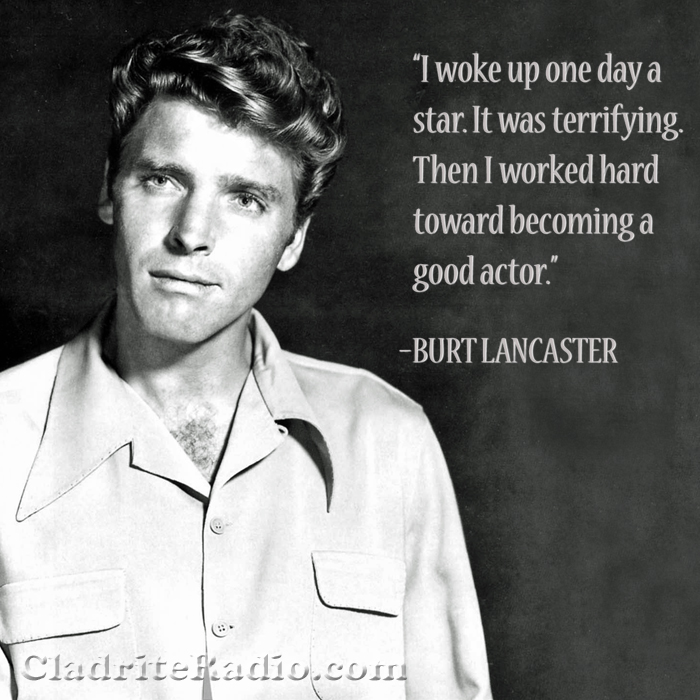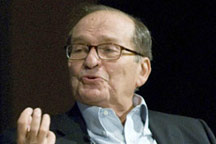Here’s wishing many happy and healthy returns of the day to Ann Blyth, who celebrates her 93rd birthday today. Here are 10 things you should know about this versatile actress.
Tag: Paul Newman
Happy 103rd Birthday, Burt Lancaster!
Burt Lancaster was born 103 years ago today in Manhattan, New York, and rarely has a movie star taken his acting more seriously. Here are 10 BL Did-You-Knows:
- All four of Lancaster’s grandparents came to the United States from Northern Ireland. His father was a postal worker.
- As a kid, Lancaster was interested in gymnastics and he eventually joined the circus, where he remained until he sustained an injury. He graduated in 1930 from DeWitt Clinton High School in the Bronx.
- Lancaster was nominated four times for the Best Actor in a Leading Role Oscar, winning once, for Elmer Gantry (1960).
- After actor John Garfield turned down the role of Stanley Kowalski in the original Broadway production of A Streetcar Named Desire, it was offered to Lancaster, who also passed. It’s said that Lancaster, given the acclaim that came to Marlon Brando in that role, felt competitive thereafter with Brando and was inspired to become more adventurous in his own choice of projects.
- Lancaster, whose political views were liberal, flew back from Europe, where he was making a film, to take part in Martin Luther King‘s March on Washington for Jobs and Freedom on August 1963, where he was joined by other stars, among them Brando, Sammy Davis Jr., Charlton Heston, Judy Garland, Eartha Kitt, Harry Belafonte, Sidney Poitier and Paul Newman. Lancaster also contributed financially to Dr. King’s work and to the Southern Christian Leadership Conference.
- Lancaster always stipulated that a high bar be made available on set while he was making a film, so that he could exercise in between scenes.
- Lancaster’s son Bill Lancaster, screenwriter for The Bad News Bears (1976), based that script on his own Little League experiences playing for his father, who coached his team.
- Lancaster’s first television role was a 1969 guest appearance on Sesame Street.
- Lancaster’s was among the 575 names on Richard Nixon‘s infamous “enemies list.”
- Among the prominent roles Lancaster turned down were Moses in the 1959 remake of Ben-Hur (he was offered $1 million for the role) and Gen. George S. Patton in Patton (1970). A role he avidly pursued but was denied was Don Corleone in The Godfather (1972).
- Though they were closely associated in the minds of many fans, Lancaster and Kirk Douglas, who made seven films together between 1948 and 1986, did not enjoy a close relationship.
Happy birthday, Burt Lancaster, wherever you may be!

The curtain is drawn on a great director
 In February 2008, NYC’s Film Forum held a tribute to director Sidney Lumet, who died today at the age of 86. The celebration of Lumet’s life and career took the form of a two-hour Q&A, interspersed with clips from some of his most memorable films. We were lucky enough to be on hand, and we are pleased to offer, as a tribute to a very talented movie maker, our account of the evening.
In February 2008, NYC’s Film Forum held a tribute to director Sidney Lumet, who died today at the age of 86. The celebration of Lumet’s life and career took the form of a two-hour Q&A, interspersed with clips from some of his most memorable films. We were lucky enough to be on hand, and we are pleased to offer, as a tribute to a very talented movie maker, our account of the evening.
Lumet shared in the early part of the discussion that his father, Baruch, was an actor in the Yiddish theatre, and Sidney himself got his start there at a very early age.
Lumet went on to appear in a number of Broadway shows, among them a Max Reinhardt production, before slipping behind the camera as a television director in the 1950s.
So it was fitting that the evening opened with a clip from One Third of a Nation (1939), which boasts Lumet’s only film acting appearance. The then-14-year-old director-to-be starred as the nephew of Sylvia Sidney.
The next clip shown was from the first movie he directed, Twelve Angry Men (1957). Asked if he’d made a specific effort to make the film in a cinematic style, so as to prove to the industry bigwigs that he could direct as well for the large screen as for the small, Lumet admitted with a laugh, “I was too arrogant. It never occurred to me that I might need to convince anyone.”
Asked later about working with Henry Fonda, Lumet said Fonda was constitutionally unable to make a false or dishonest move as an actor. “I don’t think he could’ve done it if I’d asked him to,” Lumet said. “He could only play the truth.”
Lumet said that filming on Twelve Angry Men was completed in 19 days. He said he shot the film in a very particular way. There were three levels of lighting in the film—sunlight through the windows, cloudy skies, as a storm approached outside, and with the overhead lighting in the jury room illuminated once the storm is underway.
Lumet shot the film entirely out of sequence, rotating around the room, getting each shot he needed from each actor under that particular lighting. Once he’d shot all of his sunlit shots, Lumet had the set relit to suggest cloudy conditions and slowly worked his way around the room again, going from character to character, getting every shot he needed.
Finally, he had the set relit once last time, with overhead lighting lit, and made the rounds again.
Lumet said he never used storyboards, as Alfred Hitchcock was famous for doing. Instead, he preferred to rehearse his actors for two weeks, as if they were mounting a play, and when he had all the blocking down, then he considered where to place the camera in each scene.
Read More »
